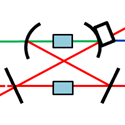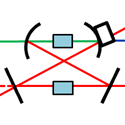Multiple entanglements
Quantum computers might one day allow exponential speedups in tasks such as large-integer factoring, but there is a price: the need to precisely control and coordinate many fragile qubits in a series of error-free steps. Among the proposals for achieving this, one “top-down” architecture relies on the normal modes of an optical system (think of a set of quantum harmonic oscillators) to act as qubits. The trick is to create and manipulate entanglement of these modes, called Qmodes, in ways suitable for information processing. In a paper in Physical Review Letters, Matthew Pysher at the University of Virginia, US, and colleagues now report the largest collection of Qmodes to date and suggest how the technique might be scaled to encompass more.
To generate the Qmodes, the authors use an optical parametric oscillator, a device with the handy ability to take a single photon as input and emit two entangled photons. The parametric oscillator can be driven to create an optical frequency comb, which is a series of Qmodes separated by known frequencies and precisely related to each other in phase. Pysher et al. were able to engineer groups of four entangled Qmodes each, for a total of . However, this was only the number of entangled modes they could measure; the authors believe that substantially more modes, perhaps as many as groups, were actually created. With this result, the authors hope to set a course for massive entanglement of many modes into a single group, a prerequisite for any all-optical quantum computer. – David Voss
Note added (19 July 2011): The text has been revised to reflect the fact that Pysher et al. study continuous-value modes (Qmodes) and not qubits (quantum binary digits).





